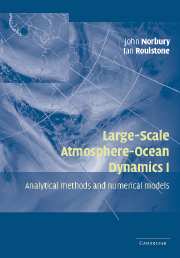Book contents
- Frontmatter
- Contents
- Contributors
- Preface
- Introduction and Scientific Background
- 1 A view of the equations of meteorological dynamics and various approximations
- 2 Extended-geostrophic Euler–Poincaré models for mesoscale oceanographic flow
- 3 Fast singular oscillating limits of stably-stratified 3D Euler and Navier–Stokes equations and ageostrophic wave fronts
- 4 New mathematical developments in atmosphere and ocean dynamics, and their application to computer simulations
- 5 Rearrangements of functions with applications to meteorology and ideal fluid flow
- 6 Statistical methods in atmospheric dynamics: probability metrics and discrepancy measures as a means of defining balance
3 - Fast singular oscillating limits of stably-stratified 3D Euler and Navier–Stokes equations and ageostrophic wave fronts
Published online by Cambridge University Press: 04 February 2010
- Frontmatter
- Contents
- Contributors
- Preface
- Introduction and Scientific Background
- 1 A view of the equations of meteorological dynamics and various approximations
- 2 Extended-geostrophic Euler–Poincaré models for mesoscale oceanographic flow
- 3 Fast singular oscillating limits of stably-stratified 3D Euler and Navier–Stokes equations and ageostrophic wave fronts
- 4 New mathematical developments in atmosphere and ocean dynamics, and their application to computer simulations
- 5 Rearrangements of functions with applications to meteorology and ideal fluid flow
- 6 Statistical methods in atmospheric dynamics: probability metrics and discrepancy measures as a means of defining balance
Summary
Introduction
Flows that are stably-stratified or are rotating have certain distinct characteristics which, unlike many flows, vary greatly in their form depending on how the flows are initiated. The characteristics also change as the flows move towards their respective equilibrium or quasi-equilibrium states. The initial effects of rotational and buoyancy forces with time scales 1/f0 and 1/N0, respectively, are to produce internal waves on those time scales and hence to exchange energy between distant points in the flow leading to significant changes in the form of the imposed flow. Here N0 is the Brunt-Väisälä wave frequency and f0 = 2Ω0 is the Coriolis parameter. The significance of the wave motion depends on the relative magnitude of the flow's time scale, T, to the rotational and buoyancy time scales. The length scales L and geometric shape (especially the ratio of the vertical to horizontal scale, H/L) of the initial disturbances are equally significant in determining the anisotropic form of the wave motion and the orientation of the constrained equilibrium forms, such as the ‘Taylor’ columns parallel to the rotation axis in rotation-dominated regimes, or the horizontal ‘pancakes’ or fronts characteristic of strong stable stratification in stratification-dominated regimes with rotation.
- Type
- Chapter
- Information
- Large-Scale Atmosphere-Ocean DynamicsAnalytical Methods and Numerical Models, pp. 126 - 201Publisher: Cambridge University PressPrint publication year: 2002
- 10
- Cited by



